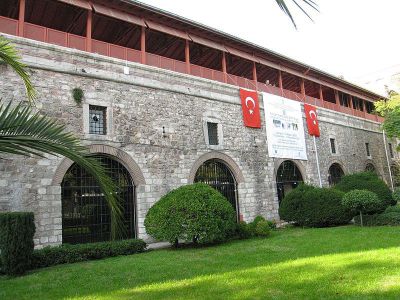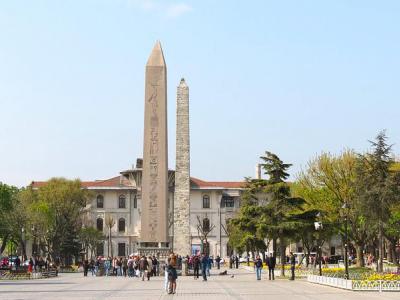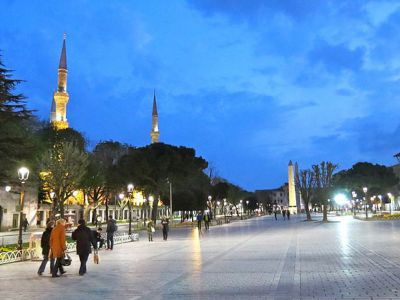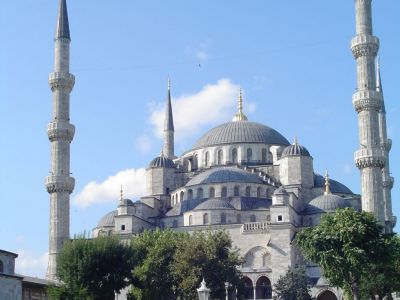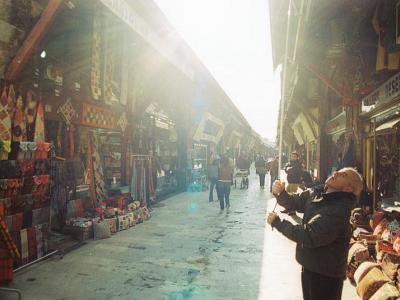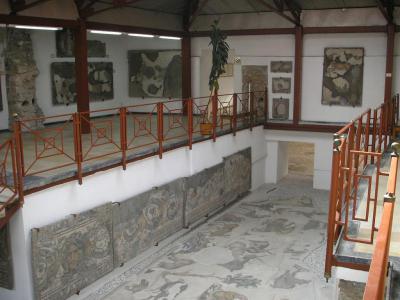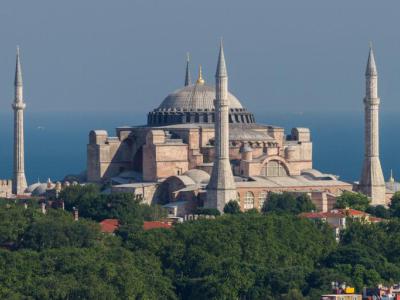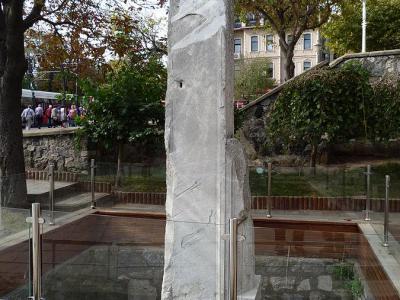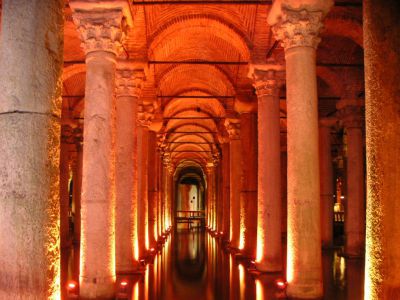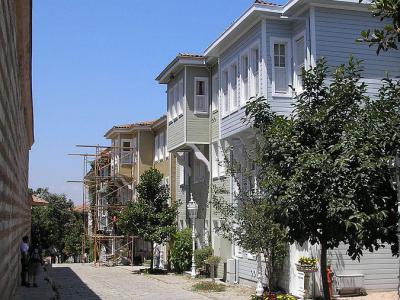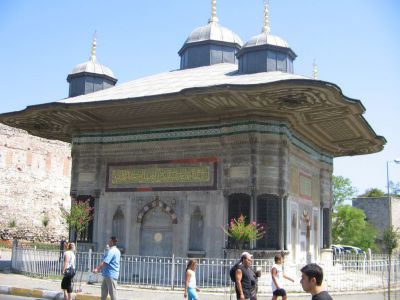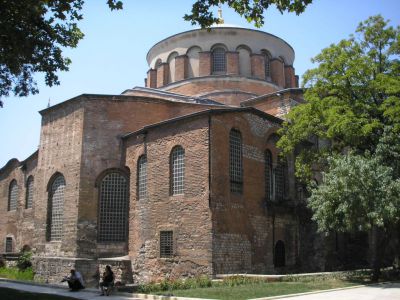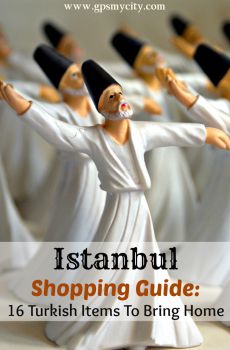
Istanbul Old City Walking Tour (Self Guided), Istanbul
Situated at the heart of Old Istanbul, the Sultanahmet neighborhood is a fascinating hub of historical timeline. Dramatically located on a peninsula pointing across the Bosphorus Strait to Asia, this area was formerly an administrative pole of the Roman, Byzantine and Ottoman empires, and as such, reflects numerous influences of the cultures once prevalent here.
Whether you feel like walking the ancient city walls, haggling in historic bazaars or absorbing the sanctity of mosques, or perhaps watching the sun go down on the Golden Horn or relaxing in a Turkish bath, there’s plenty you can do in Old Istanbul, aptly known as “the city of the world’s desire.”
Flanked by shops, hotels and traditional eateries, this popular district also abounds in historic locations. Over the course of nearly five centuries, the Ottomans had transformed the face of Constantinople (the city's name predating “Istanbul”) with a vast building scheme that included the construction of towering mosques and ornate palaces. The striking Blue Mosque with its iconic minarets, along with the famed, mosaic-filled 6th-century Hagia Sophia, originally a Christian church, along with the Egyptian Obelisk of Theodosius and the nearby 4th-century Stone of Million pillar ruin are just some of the remnants of the bygone era.
Close to The Stone of Million, the starting point of any distance measured within the Byzantine empire, is the entrance to Basilica Cistern, one of Istanbul’s most intriguing locations, fit to give anyone chills.
Found in Sultanahmet Square the Turkish and Islamic Arts Museum is the former palace of the grand vizier to Suleiman the Magnificent, constructed in 1524. Another former royal residence, the Topkapi Palace was the nerve center of the Byzantine Empire, comprising a complex of buildings set among gardens, to explore which in its entirety a half-day visit would barely suffice.
To visit these and other majestic sights in the fascinating Old City of Istanbul, take our self-guided walking tour.
Whether you feel like walking the ancient city walls, haggling in historic bazaars or absorbing the sanctity of mosques, or perhaps watching the sun go down on the Golden Horn or relaxing in a Turkish bath, there’s plenty you can do in Old Istanbul, aptly known as “the city of the world’s desire.”
Flanked by shops, hotels and traditional eateries, this popular district also abounds in historic locations. Over the course of nearly five centuries, the Ottomans had transformed the face of Constantinople (the city's name predating “Istanbul”) with a vast building scheme that included the construction of towering mosques and ornate palaces. The striking Blue Mosque with its iconic minarets, along with the famed, mosaic-filled 6th-century Hagia Sophia, originally a Christian church, along with the Egyptian Obelisk of Theodosius and the nearby 4th-century Stone of Million pillar ruin are just some of the remnants of the bygone era.
Close to The Stone of Million, the starting point of any distance measured within the Byzantine empire, is the entrance to Basilica Cistern, one of Istanbul’s most intriguing locations, fit to give anyone chills.
Found in Sultanahmet Square the Turkish and Islamic Arts Museum is the former palace of the grand vizier to Suleiman the Magnificent, constructed in 1524. Another former royal residence, the Topkapi Palace was the nerve center of the Byzantine Empire, comprising a complex of buildings set among gardens, to explore which in its entirety a half-day visit would barely suffice.
To visit these and other majestic sights in the fascinating Old City of Istanbul, take our self-guided walking tour.
How it works: Download the app "GPSmyCity: Walks in 1K+ Cities" from Apple App Store or Google Play Store to your mobile phone or tablet. The app turns your mobile device into a personal tour guide and its built-in GPS navigation functions guide you from one tour stop to next. The app works offline, so no data plan is needed when traveling abroad.
Istanbul Old City Walking Tour Map
Guide Name: Istanbul Old City Walking Tour
Guide Location: Turkey » Istanbul (See other walking tours in Istanbul)
Guide Type: Self-guided Walking Tour (Sightseeing)
# of Attractions: 14
Tour Duration: 2 Hour(s)
Travel Distance: 2.3 Km or 1.4 Miles
Author: kane
Sight(s) Featured in This Guide:
Guide Location: Turkey » Istanbul (See other walking tours in Istanbul)
Guide Type: Self-guided Walking Tour (Sightseeing)
# of Attractions: 14
Tour Duration: 2 Hour(s)
Travel Distance: 2.3 Km or 1.4 Miles
Author: kane
Sight(s) Featured in This Guide:
- Turkish and Islamic Arts Museum
- Obelisk of Theodosius (Egyptian Obelisk)
- Sultanahmet Square
- Blue Mosque
- Arasta Bazaar
- Great Palace Mosaics Museum
- Hurrem Sultan Hamam
- Hagia Sophia (Ayasofya)
- The Stone of Million
- Basilica Cistern (Yerebatan Sarnıcı)
- Sogukcesme Street
- Fountain of Ahmed III
- Hagia Irene
- Topkapi Palace
1) Turkish and Islamic Arts Museum
The Turkish and Islamic Arts Museum in Sultanahmet Square sits in a palace that has a great deal of archaeology and history attached to it. The palace was built in 1524 above the underground ruins of an ancient Hippodrome, and was designated for Pargalı Ibrahim Pasha, a confidant and second grand vizier to Sultan Suleiman the Magnificent, who later also married the Sultan's sister, Hatice Sultan. As history has it, the higher the climb, the greater the fall. Jealous people, including the Sultan's wife, didn't like the influence Ibrahim Pasha had on the monarch and eventually convinced Suleyman in Ibrahim's disloyalty, so he had him executed.
But the palace remained and today houses a museum showcasing over 40,000 exhibits of Islamic art – primarily from the Ottoman era, but also a substantial collection from the earlier Seljuk Turkish period, including illuminated Korans, carpets, miniature paintings, notable examples of Islamic calligraphy, tiles, ceramics, rugs and wooden carvings. In the basement there are interesting ethnographic displays on various cultures of Turkey, particularly the nomadic groups, recreating dwellings from different historic epochs and regions.
Being just a stone's throw away from the tourist hot spots of the Blue Mosque and Hagia Sofia, this museum offers an enjoyable break away from the hustle and bustle of the Old Town.
But the palace remained and today houses a museum showcasing over 40,000 exhibits of Islamic art – primarily from the Ottoman era, but also a substantial collection from the earlier Seljuk Turkish period, including illuminated Korans, carpets, miniature paintings, notable examples of Islamic calligraphy, tiles, ceramics, rugs and wooden carvings. In the basement there are interesting ethnographic displays on various cultures of Turkey, particularly the nomadic groups, recreating dwellings from different historic epochs and regions.
Being just a stone's throw away from the tourist hot spots of the Blue Mosque and Hagia Sofia, this museum offers an enjoyable break away from the hustle and bustle of the Old Town.
2) Obelisk of Theodosius (Egyptian Obelisk)
Commissioned by Pharaoh Thutmose III in the 15th century BC, the Egyptian Obelisk has four faces with a single central column of inscription, celebrating the Pharaoh's victory over the Mitanni which took place on the banks of the Euphrates in about 1450 BC. With the ascent of the Hittite Empire, Mitanni and Egypt eventually struck an alliance to protect their mutual interests from the threat of Hittite domination.
What you see is only the top third of the original obelisk built for the great temple of Karnak in Egypt, which the Romans had cut into pieces and shipped up the river Nile to Alexandria in 390 AD. This top section has survived nearly 3,500 years in astonishingly good condition., and it stands today where Emperor Theodosius placed it, on a marble pedestal, to commemorate his 20th anniversary on the throne of Constantinople. The reliefs on the pedestal show Theodosius as he offers a laurel wreath to the victor from the Kathisma (Imperial box) at the Hippodrome.
If you're around the area, give this monument a look. Its towering figure inside a peaceful park is rather exciting, especially for history buffs.
What you see is only the top third of the original obelisk built for the great temple of Karnak in Egypt, which the Romans had cut into pieces and shipped up the river Nile to Alexandria in 390 AD. This top section has survived nearly 3,500 years in astonishingly good condition., and it stands today where Emperor Theodosius placed it, on a marble pedestal, to commemorate his 20th anniversary on the throne of Constantinople. The reliefs on the pedestal show Theodosius as he offers a laurel wreath to the victor from the Kathisma (Imperial box) at the Hippodrome.
If you're around the area, give this monument a look. Its towering figure inside a peaceful park is rather exciting, especially for history buffs.
3) Sultanahmet Square (must see)
The former Hippodrome of Constantinople, a circus arena where chariot races and other sporting events once marked the heyday of the Byzantine Empire, today got a new life in the form of Sultanahmet Meydanı (Sultan Ahmet Square) in the heart of modern-day Istanbul. Here, alongside a few surviving fragments of the ancient Hippodrome, you will find all the famous landmarks of the city, including the Blue Mosque, Hagia Sophia, Topkapi Palace Museum, Sultan Ahmed Mosque, Suleymaniye Mosque, Serpents column, the Museum of Turkish & Islamic Arts and many others. The Basilica Cistern is a mere 40m walk from the square and the Grand Bazaar is within a walking distance, too.
The square is very large and has lots of benches scattered around which is quite convenient for taking a break after long hours of sightseeing and/or for grabbing a quick bite from one of the food carts abound in the area selling a variety of breads, roasted corn and chestnuts, simit (Turkish pretzel) with or without chocolate cream, and plenty more. Along the tram line on both sides there are shops, restaurants and cafes offering generous selections of teas, coffee, Turkish Delights and gift packs.
As a gathering place, Sultanahmet is continuously bustling with tourists and locals alike, families enjoying the colorful artezian fountain, children running along the greenery between alleys, and the elderly folk basking in the brightness of life all around them. The square is also home to a large number of street cats and dogs who seem to be rather friendly and keep to themselves. The place is open to the elements and provides very little cover, so carrying an umbrella or raincoat, if rain is predicted, is highly recommended.
The square is very large and has lots of benches scattered around which is quite convenient for taking a break after long hours of sightseeing and/or for grabbing a quick bite from one of the food carts abound in the area selling a variety of breads, roasted corn and chestnuts, simit (Turkish pretzel) with or without chocolate cream, and plenty more. Along the tram line on both sides there are shops, restaurants and cafes offering generous selections of teas, coffee, Turkish Delights and gift packs.
As a gathering place, Sultanahmet is continuously bustling with tourists and locals alike, families enjoying the colorful artezian fountain, children running along the greenery between alleys, and the elderly folk basking in the brightness of life all around them. The square is also home to a large number of street cats and dogs who seem to be rather friendly and keep to themselves. The place is open to the elements and provides very little cover, so carrying an umbrella or raincoat, if rain is predicted, is highly recommended.
4) Blue Mosque (must see)
One of the most frequently visited and famous tourist spots in Istanbul, the Sultan Ahmed Mosque – popularly known as the “Blue Mosque” due to the blue tiles that adorn the walls of its interior – was built between 1609 and 1616 during the reign of Ahmed the First. It contains a tomb of the Sultan, a madrassah (religious school) and also a hospice. Despite being a very famous tourist attraction, it still functions as a mosque, and a call for prayer (azaan) still draws the faithful to its gates from far and wide. Usually accessible 24 hours a day, the mosque is not open for tourists during prayer time (which is approximately half an hour) five times a day, unless they are there to pray.
Built near the Hagia Sophia and surrounded by a popular tourist district, visitors to the mosque can enjoy several museums, cafes, restaurants and parks in the nearby vicinity. The mosque itself was originally built on the site of the ancient Byzantine Imperial Palace and Hippodrome and took nearly seven years to complete. This masterpiece of Ottoman architecture boasts many examples of Islamic Art and calligraphy that adorn its walls from the inside.
Why You Should Visit:
Compared to other mosques in Istanbul, this one is significantly easier to access because of its free admission and central location.
Timings are strict, a dress code is enforced and the queues are long, but the sense of tranquility that you get inside (even with crowds around) is worth it all.
Tip:
Go early to avoid queues and if you need to wait, look at the details rather than focus on the line. The details in Islamic architecture/design are what sets it apart.
Close by, there are places to eat and drink if you need sustenance after or before visiting.
You could also simply walk around it as much as you are allowed, and snap some pics.
Built near the Hagia Sophia and surrounded by a popular tourist district, visitors to the mosque can enjoy several museums, cafes, restaurants and parks in the nearby vicinity. The mosque itself was originally built on the site of the ancient Byzantine Imperial Palace and Hippodrome and took nearly seven years to complete. This masterpiece of Ottoman architecture boasts many examples of Islamic Art and calligraphy that adorn its walls from the inside.
Why You Should Visit:
Compared to other mosques in Istanbul, this one is significantly easier to access because of its free admission and central location.
Timings are strict, a dress code is enforced and the queues are long, but the sense of tranquility that you get inside (even with crowds around) is worth it all.
Tip:
Go early to avoid queues and if you need to wait, look at the details rather than focus on the line. The details in Islamic architecture/design are what sets it apart.
Close by, there are places to eat and drink if you need sustenance after or before visiting.
You could also simply walk around it as much as you are allowed, and snap some pics.
5) Arasta Bazaar
Arasta Bazaar is a well-known, albeit modest open-air market in the heart of Istanbul. Located on the north side of narrow Torun Street, behind the Blue Mosque, the bazaar was built in the 17th century with the idea to use rental revenues from its shops to subsidize the upkeep of the mosque. For many years later, the shops remained empty until the tourism boom of the late 1980s-90s prompted their restoration, making it one of Istanbul's most-visited tourist markets.
If you're tired of or simply don't have time for the Grand Bazaar but still need to buy authentic goods or souvenirs, Arasta Bazaar is a good alternative. Considerably smaller (just a fraction of the Grand Bazaar), cleaner, quieter and less crowded, the Arasta makes both shopping and sightseeing very convenient. Here you will find more than 70 stores selling carpets, kilims, jewelry, pottery, spices, teas, coffee, ceramics, textiles, handicrafts, souvenirs, tiles, scarves and apparel in abundance.
Prices may appear a bit higher than the Grand Bazaar, but still reasonable, and even more so after haggling. The place is quite relaxing to stroll through whilst being invited by dozens of accomplished salesmen speaking fluent English (and a half dozen other languages, too), with bottomless treasure troves of ironic humor and topical jokes, to have a look, take a seat, sip some Turkish coffee or tea and consider the purchase.
Whilst here, you can also visit the Great Palace Mosaic Museum underneath the bazaar. The mosaics found in the environs of the Arasta during excavation works in the 1930s proved that the territory once formed part of the Byzantine-era Great Palace complex.
If you're tired of or simply don't have time for the Grand Bazaar but still need to buy authentic goods or souvenirs, Arasta Bazaar is a good alternative. Considerably smaller (just a fraction of the Grand Bazaar), cleaner, quieter and less crowded, the Arasta makes both shopping and sightseeing very convenient. Here you will find more than 70 stores selling carpets, kilims, jewelry, pottery, spices, teas, coffee, ceramics, textiles, handicrafts, souvenirs, tiles, scarves and apparel in abundance.
Prices may appear a bit higher than the Grand Bazaar, but still reasonable, and even more so after haggling. The place is quite relaxing to stroll through whilst being invited by dozens of accomplished salesmen speaking fluent English (and a half dozen other languages, too), with bottomless treasure troves of ironic humor and topical jokes, to have a look, take a seat, sip some Turkish coffee or tea and consider the purchase.
Whilst here, you can also visit the Great Palace Mosaic Museum underneath the bazaar. The mosaics found in the environs of the Arasta during excavation works in the 1930s proved that the territory once formed part of the Byzantine-era Great Palace complex.
6) Great Palace Mosaics Museum
The Museum of Great Palace Mosaics is a bi-level gallery within the Blue Mosque compound, beneath the Arasta Bazaar. It hosts one of the most beautiful pavement mosaics in the world unearthed at the site of the Byzantine-era Great Palace of Constantinople. If the mosaics of Hagia Sophia and Kariye Museum (Chora Church) left you jaw-dropped with admiration, then you should visit this place for certain.
While not as grand as the former two sites, the mosaics here are truly impressive, originated circa 450-550 AD. 40,000 pieces of limestone, earthenware and colored stones once formed part of a large (1,872 square meter) peristyle courtyard within Constantine the Great’s Palatium Magnum (Great Palace) during the East Roman period, largely predating the Ottoman's Blue Mosque.
In the 7th and 8th century, when painting was forbidden, the ground mosaics were covered with huge marble panels and forgotten. During the Ottoman era, due possible danger from the sea, the palaces were moved to the Golden Horn region and a residential district was established over the mosaics area (with no idea they were there). It wasn't until 1921 that the excavation works started after a big fire hit the area and the hidden mosaics showed up. Diggings continued throughout 1935-1951 led by archaeologists from Saint Andrews University, Scotland.
The mosaics lie largely where they were found, featuring over 150 human and animal figures, depicting daily life, mythological gods, animals in a fight and hunting scenes, and are rightfully considered one of Istanbul's greatest finds of the 20th century. The site was declared a museum in 1997.
While not as grand as the former two sites, the mosaics here are truly impressive, originated circa 450-550 AD. 40,000 pieces of limestone, earthenware and colored stones once formed part of a large (1,872 square meter) peristyle courtyard within Constantine the Great’s Palatium Magnum (Great Palace) during the East Roman period, largely predating the Ottoman's Blue Mosque.
In the 7th and 8th century, when painting was forbidden, the ground mosaics were covered with huge marble panels and forgotten. During the Ottoman era, due possible danger from the sea, the palaces were moved to the Golden Horn region and a residential district was established over the mosaics area (with no idea they were there). It wasn't until 1921 that the excavation works started after a big fire hit the area and the hidden mosaics showed up. Diggings continued throughout 1935-1951 led by archaeologists from Saint Andrews University, Scotland.
The mosaics lie largely where they were found, featuring over 150 human and animal figures, depicting daily life, mythological gods, animals in a fight and hunting scenes, and are rightfully considered one of Istanbul's greatest finds of the 20th century. The site was declared a museum in 1997.
7) Hurrem Sultan Hamam
The Ayasofya Hurrem Sultan Hamam, aka Haseki Hamam, is a bath complex in Istanbul designed and built at the request of Hurrem Sultan (Roxelana), the wife of Sultan Suleiman the Magnificent, in 1556-1557 AD. It stands on the site of the ancient public baths of Zeuxippus (100-200 AD) between the Blue Mosque and the Hagia Sophia, which is also particularly significant as the site where the Temple of Zeus once stood.
Built in the classical Ottoman style, at the total length of 75 meters, it has facilities for both men and women, and was actively in use until 1910, when it was closed and, for some time afterwards, used as a storehouse. After restoration works in the 1950s, the property was converted into a carpet shop.
In 2011, after a 13 million dollar investment and three years of meticulous restoration work, the facility reopened as a hamam once again. From the outside it may look nothing special, but as soon as you step in, you will be in awe. Today, this is one of the most luxurious traditional Turkish hamams, offering 5-star packages with 5-star services that will leave you completely blissed out. The hamam also has an on-site open-air cafe and restaurant. With the motto, "Some rituals never die," the Hurrem Sultan Hamam’s luxuries will leave you feeling like Hurrem Sultan herself.
Built in the classical Ottoman style, at the total length of 75 meters, it has facilities for both men and women, and was actively in use until 1910, when it was closed and, for some time afterwards, used as a storehouse. After restoration works in the 1950s, the property was converted into a carpet shop.
In 2011, after a 13 million dollar investment and three years of meticulous restoration work, the facility reopened as a hamam once again. From the outside it may look nothing special, but as soon as you step in, you will be in awe. Today, this is one of the most luxurious traditional Turkish hamams, offering 5-star packages with 5-star services that will leave you completely blissed out. The hamam also has an on-site open-air cafe and restaurant. With the motto, "Some rituals never die," the Hurrem Sultan Hamam’s luxuries will leave you feeling like Hurrem Sultan herself.
8) Hagia Sophia (Ayasofya) (must see)
Hagia Sophia is a significant Byzantine structure in Istanbul, renowned globally as one of the most impressive monuments. Initially constructed as a Christian church during the 6th century CE (532–537), it was commissioned by the Byzantine emperor Justinian I. The building's architecture mirrors the region's religious history with minarets, Islamic inscriptions, and intricate Christian mosaics.
The Hagia Sophia, recognized by UNESCO as a World Cultural Heritage site, stands out as a significant architectural achievement. Its grand dome, reaching a height of 180 feet and a width of 100 feet, marked a pivotal moment in architectural design. This building is accented by four minarets from the Ottoman period, added after its initial construction.
The Hagia Sophia has undergone numerous changes in its role through history, initially serving as a cathedral and becoming the core of the Eastern Orthodox Church for almost a thousand years.
When the Ottomans took over Constantinople in 1453, Sultan Mehmed II transformed it into a mosque, leading to the removal of many Christian features and the concealment of Christian images.
What stands out about the Hagia Sophia is its blend of Islamic and Christian symbols, showcasing a unique mix of religious histories. It houses a central mihrab pointing towards Mecca alongside a mosaic of the Virgin Mary and Jesus, reflecting its past as both a cathedral and a mosque.
The building is also home to stunning mosaics, including the notable 13th-century Deësis mosaic featuring Christ, John the Baptist, and the Virgin Mary.
An interesting part of the Hagia Sophia is the 'wishing column' located in the northwest section, believed to grant wishes or healing to those who follow a specific ritual involving their thumb and wrist. It's said that even Justinian found relief from a headache here.
Today, as the Hagia Sophia returns to being a place of worship, its history museum has moved to the nearby Ibrahim Pasha Palace, just a short walk from the mosque.
Why You Should Visit:
Unique in being both a church and a mosque, with pertinent symbols omnipresent.
The multi-domed enclosure is so mesmerizing that it's hard to take one's eyes off it!
Tip:
There is no entrance fee to visit Hagia Sophia Mosque, but donations are welcome. With the Istanbul Tourist Pass, you can enjoy discounted admission to Hagia Sophia History Museum. Be sure to visit either before or after your Free Guided Hagia Sophia Tour.
The Hagia Sophia, recognized by UNESCO as a World Cultural Heritage site, stands out as a significant architectural achievement. Its grand dome, reaching a height of 180 feet and a width of 100 feet, marked a pivotal moment in architectural design. This building is accented by four minarets from the Ottoman period, added after its initial construction.
The Hagia Sophia has undergone numerous changes in its role through history, initially serving as a cathedral and becoming the core of the Eastern Orthodox Church for almost a thousand years.
When the Ottomans took over Constantinople in 1453, Sultan Mehmed II transformed it into a mosque, leading to the removal of many Christian features and the concealment of Christian images.
What stands out about the Hagia Sophia is its blend of Islamic and Christian symbols, showcasing a unique mix of religious histories. It houses a central mihrab pointing towards Mecca alongside a mosaic of the Virgin Mary and Jesus, reflecting its past as both a cathedral and a mosque.
The building is also home to stunning mosaics, including the notable 13th-century Deësis mosaic featuring Christ, John the Baptist, and the Virgin Mary.
An interesting part of the Hagia Sophia is the 'wishing column' located in the northwest section, believed to grant wishes or healing to those who follow a specific ritual involving their thumb and wrist. It's said that even Justinian found relief from a headache here.
Today, as the Hagia Sophia returns to being a place of worship, its history museum has moved to the nearby Ibrahim Pasha Palace, just a short walk from the mosque.
Why You Should Visit:
Unique in being both a church and a mosque, with pertinent symbols omnipresent.
The multi-domed enclosure is so mesmerizing that it's hard to take one's eyes off it!
Tip:
There is no entrance fee to visit Hagia Sophia Mosque, but donations are welcome. With the Istanbul Tourist Pass, you can enjoy discounted admission to Hagia Sophia History Museum. Be sure to visit either before or after your Free Guided Hagia Sophia Tour.
9) The Stone of Million
The Stone of Milion is all that remains of the 4th-century triumphal gate that served as the Byzantine zero-mile marker. Consciously emulating the Golden Milestone (Milliarium Aureum) in Rome's Forum, it was considered as the origin of all the roads leading to the European cities of the Byzantine Empire, and on its base were inscribed the distances of all the main cities of the Empire from Constantinople.
The monument was actually much more complex than its Roman counterpart: a double triumphal arch surmounted by a dome, which was carried by four arches and crowned by the statues of Constantine and his mother Helena with a cross, looking towards the east, between them. A statue of the Tyche (presiding tutelary deity) of the City stood behind them.
Until the late 19th century, the zero meridian was considered to have passed through Istanbul, where there were Milion Stone once stood; therefore, many countries around the world set their clocks to Istanbul's time. In fact, the maps were prepared based on this point and directions were found here. At the 1884 International Meridian Conference, however, the "common zero of longitude and standard of time reckoning throughout the world" was moved from Istanbul to Greenwich.
The monument was actually much more complex than its Roman counterpart: a double triumphal arch surmounted by a dome, which was carried by four arches and crowned by the statues of Constantine and his mother Helena with a cross, looking towards the east, between them. A statue of the Tyche (presiding tutelary deity) of the City stood behind them.
Until the late 19th century, the zero meridian was considered to have passed through Istanbul, where there were Milion Stone once stood; therefore, many countries around the world set their clocks to Istanbul's time. In fact, the maps were prepared based on this point and directions were found here. At the 1884 International Meridian Conference, however, the "common zero of longitude and standard of time reckoning throughout the world" was moved from Istanbul to Greenwich.
10) Basilica Cistern (Yerebatan Sarnıcı) (must see)
The Yerebatan Sarnıcı or the Basilica Cistern translates as “Cistern Sinking Into Ground” and is one of the many ancient cisterns that are present in the city of Istanbul. Located near the Hagia Sophia, on the peninsula of Sarayburnu, it was built in the 6th century AD by the Byzantine emperor Justinian the first. The name is derived from the Stoa Basilica upon which it was built. The Basilica was said to be built by Ilias and housed many structures and gardens. Historical texts state that over seven thousand slaves were involved in the construction of the Cistern.
The cistern used to provide a filtration system for the water for the Great Palace of Constantinople and surrounding buildings on the historic First Hill. After the Ottoman conquest, it continued to provide water to the Topkapi Palace and continues to do so in modern times. It has undergone many restorations, both by Ottoman emperors and the Roman emperors before them.
Today, the cistern is open to visitors and houses many historical relics like the Medusa columns and triumphal arches. The former can be viewed in the cistern's North West corner.
Why You Should Visit:
Great (spooky) atmosphere that makes for magnificent photos and the preservation of history is done remarkably.
Right next to Hagia Sophia, Topkapi Palace, and the Blue Mosque, so easy to fit it in along with the other attractions.
Tip:
Watch your step as some parts (near Medusa heads) can be extra slippery, and take a jacket especially if you get cold easily.
The cistern used to provide a filtration system for the water for the Great Palace of Constantinople and surrounding buildings on the historic First Hill. After the Ottoman conquest, it continued to provide water to the Topkapi Palace and continues to do so in modern times. It has undergone many restorations, both by Ottoman emperors and the Roman emperors before them.
Today, the cistern is open to visitors and houses many historical relics like the Medusa columns and triumphal arches. The former can be viewed in the cistern's North West corner.
Why You Should Visit:
Great (spooky) atmosphere that makes for magnificent photos and the preservation of history is done remarkably.
Right next to Hagia Sophia, Topkapi Palace, and the Blue Mosque, so easy to fit it in along with the other attractions.
Tip:
Watch your step as some parts (near Medusa heads) can be extra slippery, and take a jacket especially if you get cold easily.
11) Sogukcesme Street
Soğukçeşme Sokağı (“Street of the Cold Fountain”) is a small car-free cobblestone street running downhill between Hagia Sophia and Topkapı Palace. The street is named after a fountain at its end, near Gülhane Park, and is famous primarily for holding historic wooden houses of the Ottoman era. The two-, three-storey houses (four to ten rooms each) were restored (or rather totally rebuilt) in 1985-1986 to give an idea of what typical Istanbul streetscape was like at the turn of the 20th century, before the concrete came over.
Called "Ayasofya Konakları" (Hagia Sophia Mansions), nine of the houses are used as a hostel and are named after the fragrant flower shrubs planted in front of them, namely: "Yaseminli Ev" (Jasmine House), "Mor Salkımlı Ev" (Wisteria Sinensis House), "Hanımeli Ev" (Honeysuckle House), etc. The interior furnishings – beds, consoles, silk curtains, velvet armchairs and gilded mirrors – all feature the original style. Among the notable guests of the hostel, over the years, have been Queen Sofía of Spain, Roman Polanski (film director), Sam Neil (actor), Hilary Swank (actress), Ursula Anders (actress, one of the “Bond girls”), and others.
The street also happens to be the birthplace of Turkey's 6th president Fahri Sabit Korutürk (1903–1987). One of the houses here hosts a library with over 10,000 books on Istanbul. At the one end, towards Gülhane Park, there is a Byzantine cistern housing the cute Sarnıç Restaurant.
Overall, Soğukçeşme is well worth a look, as a break from the great confusion of a huge city, to get relaxed while savoring the calm of this lovely place. Also, whilst here, make sure to check out the Fountain of Sultan Ahmed III at the square in front of the outer gate of Topkapı Palace, a huge standalone structure featuring Ottoman rococo style, built in 1728.
Called "Ayasofya Konakları" (Hagia Sophia Mansions), nine of the houses are used as a hostel and are named after the fragrant flower shrubs planted in front of them, namely: "Yaseminli Ev" (Jasmine House), "Mor Salkımlı Ev" (Wisteria Sinensis House), "Hanımeli Ev" (Honeysuckle House), etc. The interior furnishings – beds, consoles, silk curtains, velvet armchairs and gilded mirrors – all feature the original style. Among the notable guests of the hostel, over the years, have been Queen Sofía of Spain, Roman Polanski (film director), Sam Neil (actor), Hilary Swank (actress), Ursula Anders (actress, one of the “Bond girls”), and others.
The street also happens to be the birthplace of Turkey's 6th president Fahri Sabit Korutürk (1903–1987). One of the houses here hosts a library with over 10,000 books on Istanbul. At the one end, towards Gülhane Park, there is a Byzantine cistern housing the cute Sarnıç Restaurant.
Overall, Soğukçeşme is well worth a look, as a break from the great confusion of a huge city, to get relaxed while savoring the calm of this lovely place. Also, whilst here, make sure to check out the Fountain of Sultan Ahmed III at the square in front of the outer gate of Topkapı Palace, a huge standalone structure featuring Ottoman rococo style, built in 1728.
12) Fountain of Ahmed III
The Fountain of Ahmed III, otherwise known as the Ahmet Çeşmesi in Turkish, is located in front of the Imperial Gate of the great Topkapı Palace in Istanbul at the site of an older Byzantine fountain called Perayton. The fountain is a Turkish rococo structure and was built in 1728 under the Ottoman Sultan Ahmed III. During the Ottoman period, it was a very popular gathering place and social center.
The fountain's architecture is a combination of contemporary Western and traditional Ottoman styles. It consists of a large square block along with smaller domes. Foliate and floral designs decorate the Mirhab (a niche present in mosques) shaped niches present in the four facades. Each facade contains a çeşme (drinking fountain). An octagonal pool inside the kiosk supplies the water and there is space for an attendant to stand inside the fountain as well. Sherbet or water is distributed from behind a grille to people, free of charge.
Large calligraphic plates are present above the drinking fountains, which are bordered with red and blue tiles. These plates bear calligraphy of a fourteen line poem about water, donated by Seyyid Hüseyin Vehbi bin Ahmed.
The fountain's architecture is a combination of contemporary Western and traditional Ottoman styles. It consists of a large square block along with smaller domes. Foliate and floral designs decorate the Mirhab (a niche present in mosques) shaped niches present in the four facades. Each facade contains a çeşme (drinking fountain). An octagonal pool inside the kiosk supplies the water and there is space for an attendant to stand inside the fountain as well. Sherbet or water is distributed from behind a grille to people, free of charge.
Large calligraphic plates are present above the drinking fountains, which are bordered with red and blue tiles. These plates bear calligraphy of a fourteen line poem about water, donated by Seyyid Hüseyin Vehbi bin Ahmed.
13) Hagia Irene
The Hagia Irene, also known as the Hagia Eirene ("Holy Peace") in Greek and Aya İrini in Turkish, is an Eastern Orthodox Church located in Istanbul, in the outer courtyard of the Topkapı Palace. After being closed, in April 2014 it was opened to the public as a museum. The entrance fee is 20 TL per person.
The church originally stands on the location of a pre-Christian temple, and it is one of the first churches to be built in Constantinople. During the 4th century, Roman Emperor Constantine the Great commissioned the first Hagia Irene church to be built, which burned down in 532. In 538, the church was restored by Emperor Justinian I. Before the Hagia Sophia was completed, the Hagia Irene used to serve as the Patriarchate.
The building is a typical Roman basilica and consists of two naives and an aisle, which have been divided by pillars and columns. Today, the Hagia Irene is one of the last standing examples of Byzantine architecture in Istanbul which has retained its original atrium. Under Constantine V, the church’s interior was decorated with frescoes and mosaics.
Today, due to its extraordinary acoustic characteristics and impressive atmosphere, the museum plays host to the classical music concerts held as part of the Istanbul Music Festival.
The church originally stands on the location of a pre-Christian temple, and it is one of the first churches to be built in Constantinople. During the 4th century, Roman Emperor Constantine the Great commissioned the first Hagia Irene church to be built, which burned down in 532. In 538, the church was restored by Emperor Justinian I. Before the Hagia Sophia was completed, the Hagia Irene used to serve as the Patriarchate.
The building is a typical Roman basilica and consists of two naives and an aisle, which have been divided by pillars and columns. Today, the Hagia Irene is one of the last standing examples of Byzantine architecture in Istanbul which has retained its original atrium. Under Constantine V, the church’s interior was decorated with frescoes and mosaics.
Today, due to its extraordinary acoustic characteristics and impressive atmosphere, the museum plays host to the classical music concerts held as part of the Istanbul Music Festival.
14) Topkapi Palace (must see)
For most tourists, the Topkapi Palace is usually number one on the list of places to visit in Istanbul. This grand palace was the official residence of the Ottoman Sultans for almost 400 years and is also a UNESCO world heritage site since 1985.
The Topkapi Palace is built on a huge scale with four courtyards and a Harem, and each location therein houses incredible displays of Islamic art, holy relics and history. The most prized collection is that of the Islamic relics which include Prophet Mohamed’s (PBUH) sword along with the swords of his closest companions, the cloak of his daughter Fatima and other holy relics.
The spacious grounds, the many gardens and rest stops are ideal for strolling at one's leisure, but most of the exhibits have very long waiting lines, especially the Harem and the Islamic Relics displays. There is a museum shop, a cafe and also a coffee shop for tourists. To visit all the exciting places and displays in the Topkapi Palace, you need a full day or, ideally, a tour should be booked.
Why You Should Visit:
Probably the world's finest museum of applied arts; as someone who loves beauty, you will cry from the visual experience of some of the objects displayed.
And, obviously, at the end of your tour, you're welcome to take a walk around the cafe area that overlooks the Bosphorus Strait... Breathtaking!
Tip:
Do come early in the morning to avoid crowds and rent an audio guide (available in several languages) to maximize the experience.
If you want to rent the audio guide, make sure to have a valid ID ready.
Note that you cannot take photos or videos in most of the exhibit halls.
The Topkapi Palace is built on a huge scale with four courtyards and a Harem, and each location therein houses incredible displays of Islamic art, holy relics and history. The most prized collection is that of the Islamic relics which include Prophet Mohamed’s (PBUH) sword along with the swords of his closest companions, the cloak of his daughter Fatima and other holy relics.
The spacious grounds, the many gardens and rest stops are ideal for strolling at one's leisure, but most of the exhibits have very long waiting lines, especially the Harem and the Islamic Relics displays. There is a museum shop, a cafe and also a coffee shop for tourists. To visit all the exciting places and displays in the Topkapi Palace, you need a full day or, ideally, a tour should be booked.
Why You Should Visit:
Probably the world's finest museum of applied arts; as someone who loves beauty, you will cry from the visual experience of some of the objects displayed.
And, obviously, at the end of your tour, you're welcome to take a walk around the cafe area that overlooks the Bosphorus Strait... Breathtaking!
Tip:
Do come early in the morning to avoid crowds and rent an audio guide (available in several languages) to maximize the experience.
If you want to rent the audio guide, make sure to have a valid ID ready.
Note that you cannot take photos or videos in most of the exhibit halls.
Walking Tours in Istanbul, Turkey
Create Your Own Walk in Istanbul
Creating your own self-guided walk in Istanbul is easy and fun. Choose the city attractions that you want to see and a walk route map will be created just for you. You can even set your hotel as the start point of the walk.
Byzantine Heritage Walking Tour
Originated as a Greek city called Byzantium, what's now known as Istanbul initially made name as Constantinople, an Eastern Roman imperial capital whose greatness had lasted for over a millennium, from 330 AD until the Ottoman invasion in 1453.
The Byzantine Empire’s rich cultural and architectural heritage is still preserved in dazzling sites throughout the city. Away from its Islamic... view more
Tour Duration: 2 Hour(s)
Travel Distance: 2.5 Km or 1.6 Miles
The Byzantine Empire’s rich cultural and architectural heritage is still preserved in dazzling sites throughout the city. Away from its Islamic... view more
Tour Duration: 2 Hour(s)
Travel Distance: 2.5 Km or 1.6 Miles
Old European Quarter Walk
Back in the Ottoman era, the Beyoğlu neighborhood (then known as Pera) together with Galata formed the European Quarter of Istanbul. Home to embassies and trading centers, as well as the fine 19th-century, Parisian-style apartment houses, this area was much loved by the city's non-Islamic minorities.
Its growth was boosted by the opening of the Orient Express line, connecting Paris to... view more
Tour Duration: 2 Hour(s)
Travel Distance: 2.4 Km or 1.5 Miles
Its growth was boosted by the opening of the Orient Express line, connecting Paris to... view more
Tour Duration: 2 Hour(s)
Travel Distance: 2.4 Km or 1.5 Miles
Istanbul City Walls
One of the most elaborate fortification systems of ancient times, the Walls of Constantinople were built by Constantine the Great to protect the city, the then newly-established capital of the Eastern Roman Empire, from attacks by land and sea. Of these, only the Golden Gate, an old ceremonial gateway into the city, had survived by the late Byzantine Era when a new series of land walls were added... view more
Tour Duration: 2 Hour(s)
Travel Distance: 5.2 Km or 3.2 Miles
Tour Duration: 2 Hour(s)
Travel Distance: 5.2 Km or 3.2 Miles
Asian Side and Bosphorus Walking Tour
Istanbul is the only megalopolis in the world that straddles two continents. The Bosphorus Strait splits Turkey's biggest city into two parts: European and Asian. The latter, known locally as Asya Yakası (“Asian Side”), or more commonly as Anadolu Yakası (“Anatolian Side”), is found east of the strait, geographically on the Asian mainland.
The vast Anatolian shore, wrongly... view more
Tour Duration: 2 Hour(s)
Travel Distance: 4.6 Km or 2.9 Miles
The vast Anatolian shore, wrongly... view more
Tour Duration: 2 Hour(s)
Travel Distance: 4.6 Km or 2.9 Miles
Bosphorus Coast Walking Tour
One of the planet's most praised stretches of water, the Bosphorus is a source of great pride for Istanbulites and of admiration for travelers. The 30-km strait dividing Europe and Asia and connecting the Marmara with the Black Sea is one of the city's highlights, having been for all ages the subject of legend and art.
This self-guided walk will take you along the coast so that you... view more
Tour Duration: 3 Hour(s)
Travel Distance: 5.9 Km or 3.7 Miles
This self-guided walk will take you along the coast so that you... view more
Tour Duration: 3 Hour(s)
Travel Distance: 5.9 Km or 3.7 Miles
Istanbul Introduction Walking Tour
Formerly known as “Byzantium”, “Constantinople” and “New Rome”, Istanbul is the main city of Turkey, straddling the Bosphorus Strait, and as such, bridging the gap between Europe and Asia, both geographically and culturally. This ancient transcontinental metropolis embraces cultural influences of the many empires and civilizations that once ruled and flourished on this land.
... view more
Tour Duration: 2 Hour(s)
Travel Distance: 4.3 Km or 2.7 Miles
... view more
Tour Duration: 2 Hour(s)
Travel Distance: 4.3 Km or 2.7 Miles
Useful Travel Guides for Planning Your Trip
Istanbul Shopping Guide: 16 Turkish Items To Bring Home
Istanbul, known throughout history as Byzantium and Constantinople, has been a major center of commerce and trade, a place where merchants and general folk would rush to regularly in search of exotic things. In our days, modern travelers to Istanbul are also bound to enjoy a truly magnificent...
The Most Popular Cities
/ view all
